Colors blue, red and white woven into gorgeous patterns. V-neck sleeveless long gown, enchantingly beautiful and elegant. The somewhat western modern design is, surprisingly, a rare indigenous wedding dress. Musasu, a creative Atayal studio is the magical hand behind the twist to the traditional gown.
Situated inside the Zhudong Cultural Creative Art Village, Musasu echoes the natural surrounding of indigenous villages and the mountains, with the entire venue filled with timber and walls painted beige, clean and simple, highlighting the colorful indigenous clothes. The surrounding trees paint an infinite green, and the sun shines brightly through the glass window with mesmerizing shadows cast on the floor, adding an extended touch of nature inside the studio.
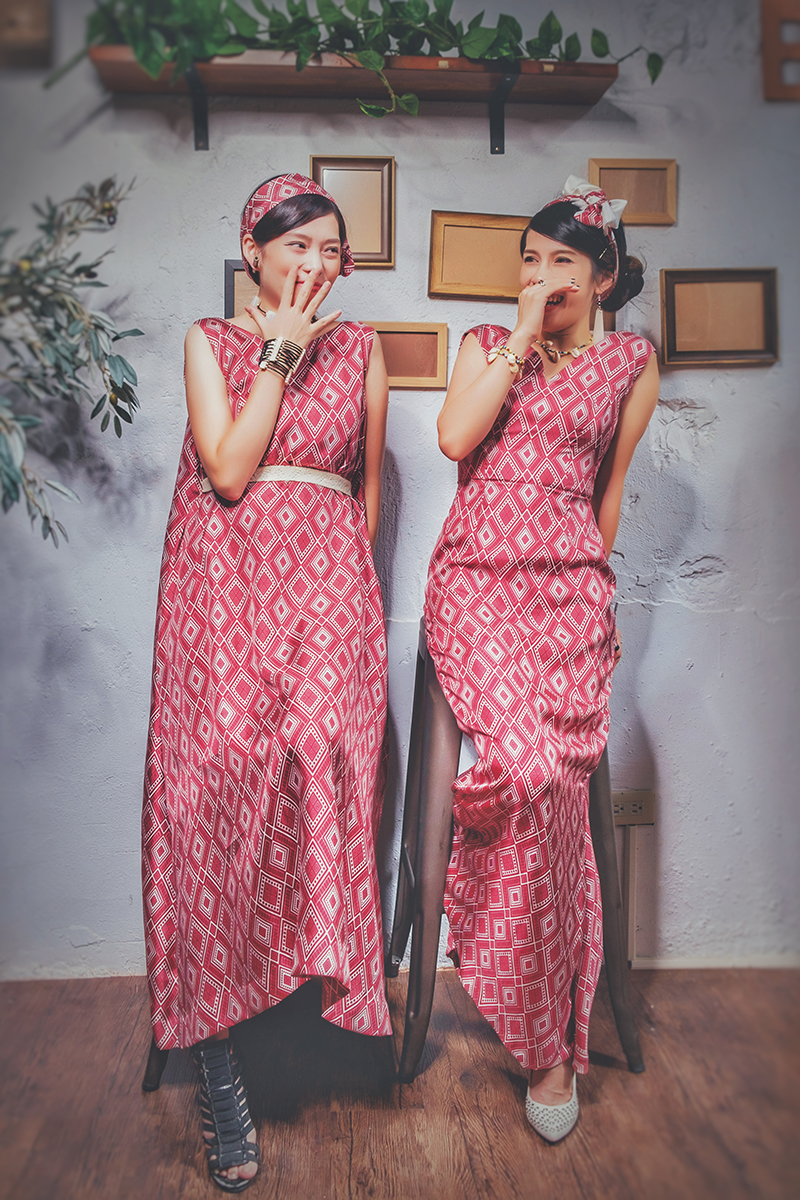
Musasu makes elegant and simple designs that appeal to the younger generation, their kimono stand out in form, attracting many lingering tourists.
Showcasing
Miciang's Superb Couture Skills
Musasu is established by thee Atayal women. MU is for Miciang, with M short for mother as well; SA is Sabung, the daughter, and SU is for Su-chin, the mother's girl friend. The experienced and skillful Miciang is in charge of all the clothing design and making at Musasu, Su-chin is her helping hand while Sabung with all her ideas takes care of the operation and marketing at the studio.
The Atayal people is one of the best weavers amongst indigenous peoples in Taiwan. According to traditional Atayal culture, weaving is the most important skill. A young girl must learn from female elders in the family how to weave, before she is qualified to get her face tattooed and get married. The quality of an Atayal woman’s weaving skill is also key to determining her social status.
“My grandmother was also a master weaver!” Sabung shared with good humor. As the same blood runs through their systems, under the influence of her mother, Miciang grew up with a fondness of making clothes and have been making Atayal clothing for two or three decades. She graduated top of her sewing class at the Vocational Training Service, operated her own couture studio, and taught indigenous women how to weave and create to provide for their families. With her excellent skills, Miciang was invited by the Council of Indigenous Peoples to participate in the World Trade Center Fashion Show and visit New Zealand on behalf of Taiwan to promote cultural exchange.
Having worked hard for many years, Miciang was worn down and had to cease the operation of her studio for quite some time. But things changed when Zhudong Cultural Creative Art Village came into being. The original site of the Art Village was the abandoned dormitory for Taiwan Railway. When Miciang learnt that it was to be turned into an Art Village, she encouraged her daughter Sabung, who has been dancing for 30 years, to establish a dance studio there. However, Sabung was set to leave for Spain for her postgraduate degree in dance and was worried that she wouldn't be in Taiwan for much longer. So instead, she convinced her mother Miciang to reopen her couture studio. And that's how Musasu, the embodiment of the spirits of three women, was established in December 2017.


Musasu not only apply the indigenous patterns onto clothes ,but to accessories including face masks, hang bags, bracelets and shoulder bags as well.
Traditional Diamonds and Horizontal Stripes
Forming Delicate Patterns
Traditional Atayal weaving involves scraping the fiber from inside the ramie stem, boil and dry the fiber until they become soft and white before being spun into thread, and finally dyed with natural vegetable or mineral dye. When weaving, the base color is usually white or red, with different colors of geometrical lines crisscrossing between, forming delicate and complicated patterns.
Musasu's clothes are based on traditional Atayal patterns. Some of the materials they use are hand-woven fabric from indigenous villages using the most authentic ramie thread, some are prints they designed or patterns they wove themselves but replaced the ramie thread with a lighter and softer Japanese cotton thread; they also bought ready-made fabric with indigenous patterns from domestic or overseas companies that are of airy cotton linen material, which is more suitable for modern daily wear.
Sabung points to the traditional patterns on the clothes and said that red, white and black are the most commonly seen color coordination in Atayal clothing. Red symbolizes the proactiveness and vitality of the Atayal people. According to their traditional belief, evil spirits are afraid of the color red, therefore wearing a red top also serves to ward off bad omen. The patterns are composed of the two basic elements of the diamond shape and horizontal stripe, with different combinations and twists. The diamond shape represents “the ancestor's eye”, as in the ancestor's gaze towards their people, and is the most iconic and classic pattern of the Atayal people. The multicolored horizontal stripes pave the way towards the “rainbow bridge”, where the ancestors rest in peace.
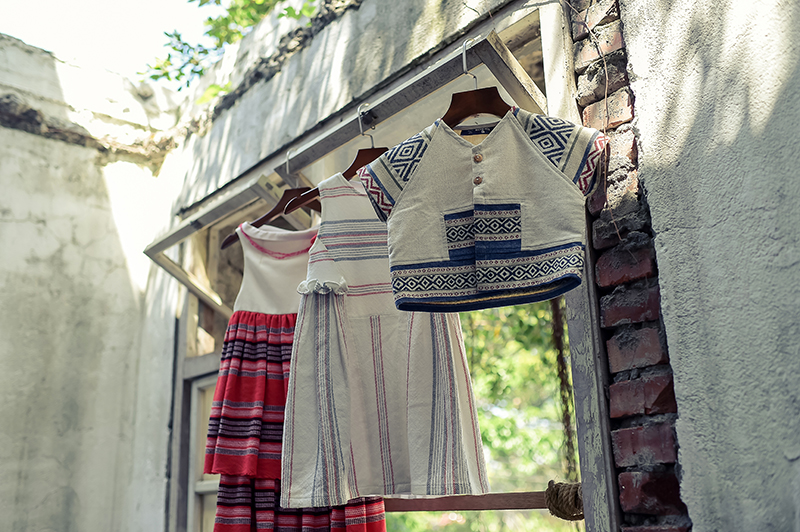
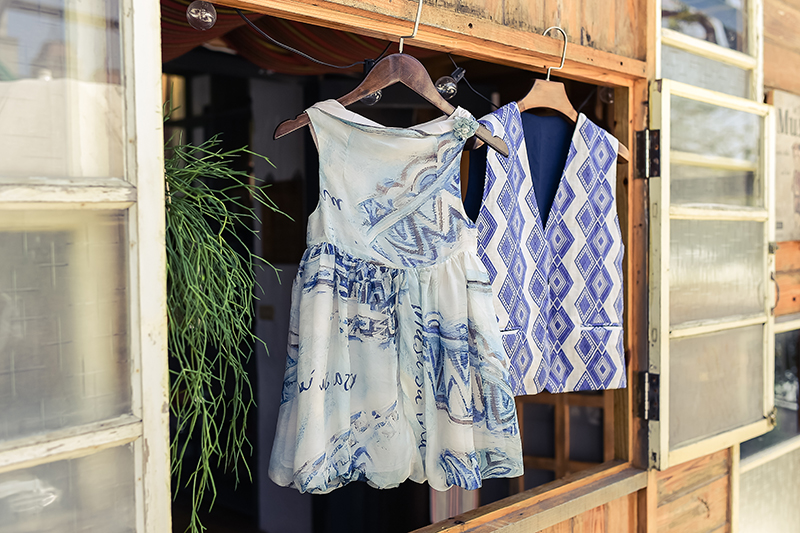
Having just had a baby, Sabung thought that it would be really cute if they designed clothes that children can wear as well.
Innovative Styles
Presenting a Refreshing Image of Indigenous Clothing
Musasu's creative designs are what gave these traditional patterns a new look. “We want Musasu clothes to be popular among not just the indigenous peoples, but also the non-indigenous people,” Sabung explains. Musasu may be traditional in the patterns, but they are creative in form with a simplified western style, “indigenous clothes are brightly colored with distinct patterns, so we don't need to complicate the designs.”
Sabung goes through the different styles in store, the simple shirt, sleeveless top, the high waist dress for children, each piece is modern and sleek in cutting. The spaghetti string short top paired with high waist long skirt shows a charming waistline, the fashionable style is far from what people expected of indigenous clothing, with a hint of laid-back Bohemian flair, it takes the aesthetics of indigenous clothing to another level. The vest is a popular item in the store, it is easy to wear and stylish with a touch of indigenous culture, a couple of sisters bought one for their father as birthday present.
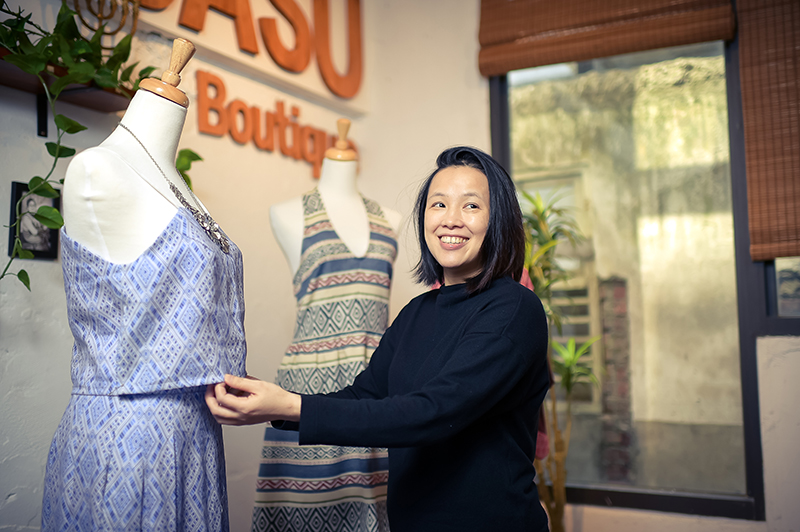
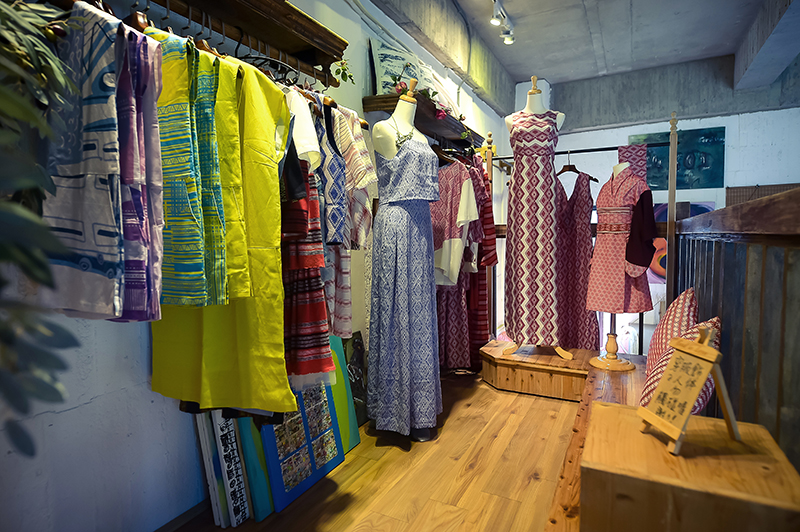
Sabung had an artistic upbringing and shares all her inspirations for clothing design with Miciang, who then transforms them into reality.
Not Just Everyday Wear
Also Known for Wedding Dress and Kimono
In addition to regular clothes, Musasu also specialize in wedding dresses and gowns. When Miciang operated her couture studio in the past, people would come to her for bespoke gowns and wedding dresses, “the younger generation wants to get married in modern gowns, but not many tailors actually can make wedding dresses, neither the sewing nor the ratio is the same as regular clothes. It requires a really skilled and experienced tailor,” explained Sabung.
The bride's mother's dress and groom's vest is another speciality of Musasu. A non-indigenous violinist once wore Musasu vest at his recital, demonstrating indigenous cultures in a different way. Kimono is yet another style they specialize in. It was Sabung's idea to combine traditional patterns with Japanese clothing, “I love the Japanese culture, so I wanted to see what it would be like to blend the two, and it was surprisingly fantastic!”
Although Miciang is in charge of all the clothing design and making, Sabung pitches in creatively from time to time as well. Sabung's artistic talent is displayed in not only dancing, but painting. She prints her smudge paintings onto clothes, and you can see her paintings of clothes on the wall.

Miciang is the soul of Musasu, performing magic with her hands, making one after another elegantly dazzling clothes.
Act First
When it Comes to Promoting Culture
Musasu mainly takes bespoke orders, each piece of clothing requires approximately two weeks to a month to complete. With its start in custom-made clothing, Musasu began its transformation in 2019 to provide coffee and light meal in the store, and starting this April they also host musical events, “we want to attract more people inside with the different elements, to take photographs and even check in online, so that more people know we offer indigenous clothing here.” Sabung shared that two curious kids once came inside the shop asking about the clothes, and through the interactions, they introduced the Atayal culture to the kids.
“If we only sell our clothes to indigenous peoples, we will make limited impact; only when we reach more people with our clothes, will we be able to further promote our culture. If we stick to the traditions only, it will die out again very soon,” Sabung said with a sigh.
Musasu's determination to promote the Atayal culture has long been implied by its namesake. Not only is Musasu the abbreviation of the names of the three founders, it also means “to take action” in the Atayal language. Sabung said that they chose this name because, “we should act first! When you are promoting culture, you just need to act first, learn from your mistakes and then improve.”
To Musasu, the most important thing is this determination to take “action”, with each attempt there will be feedback, and with it comes the chance to further promote their culture. “Nothing is more important than sustaining our culture,” Sabung said with firmness. Not only is Musasu reinterpreting the beauty of indigenous clothing, but they are sewing firmly onto the beautiful clothes the culture of the Atayal so that more may bear witness.




